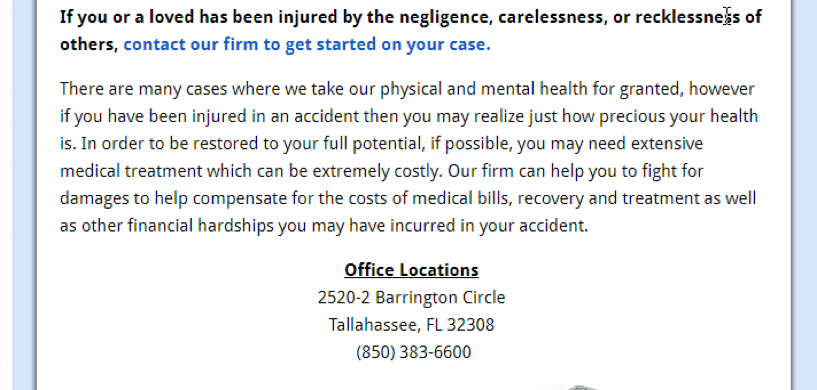We already know that if your law practice isn’t present online, you’re depriving yourself and your potential clients from finding you. A good website is one of the best ways for a broad range of clients to find your services, learn about what you do, and most importantly, get in contact with you. This is essential when considering that even way back in 2013, 76 percent of consumers used online resources when looking for an attorney.
Once your site has convinced a visitor that you can handle their needs, they’ll want to contact you. The methods and devices people use to access the Internet have changed significantly according to iLawyerMarketing’s study. They asked participants what devices they’re most likely to use when searching the internet for law firms, and overwhelmingly, the most common answer was smartphones, followed by a combination of smartphones and a desktop or laptop computer—this means making sure that your website works just as well from a mobile device as it does from a personal computer.
The value of traffic from phone calls can’t be understated: A Google-commissioned survey performed by Ipsos asked which phase of decision-making is most likely to involve a phone call to a business. Findings here are critical to how your law firm designs an online experience: 65 percent of respondents said they’re most likely to call during the research phase, and 68 percent said they’re most likely to call once they’re ready to purchase. Lucky for you—we’ve compiled 3 easy ways to use the phone to your advantage.
Make Your Contact Information Impossible to Miss
According to the 2014 U.S Consumer Legal Needs Survey, 74 percent of those who begin a search for an attorney online end up contacting via phone, so making your phone number clearly accessible is everything. Therefore, it’s a good practice to add a phone number at the bottom of every page on your website, as well as at the end of certain passages of text. When a visitor is finished reading, they’re immediately faced with a phone number they can easily call. This Tallahassee law firm’s website does a good job:
The office’s address and phone number immediately follows the text, which itself includes a link to their contact form.
Images: pelhamlaw.com
They also feature their phone number at the bottom and top of every webpage, in addition to a separate “Contact Us” tab. With even a quick scroll through their site, you know the information you’d need to contact them is available with just about zero effort required to find it.
Enable Click-to-Call
The same Google survey referenced above found that 72 percent of those who search for local professional services are “extremely likely” or “very likely” to call a business if a phone number is accessible directly from search engine results. This means ensuring that your website works smoothly from a mobile device is paramount—especially since they’ll likely be contacting you from the same device they used to find your website.
These local firms, as well as a button that places a call to them, are available immediately from a search of “Tallahassee law firms”. This feature will also allow your site visitors to tap your number and automatically initiate a call. The ability to call a firm immediately after searching greatly increases the likelihood of an interested party giving you a call—if there’s one thing you make sure of when it comes to your firm’s Web presence, it’s this. (Your trusty website provider can help you with this)
Choose a Phone System to Back You Up
Now they’ve looked through your site, found your contact information, and they’re ready to call—there’s even a decent chance they’re ready to do business. Do you have a telephone system in place that can make sure every caller’s voice is heard? Any attorney knows they spend a lot of time fielding phone calls; they might even have a receptionist or someone else do it for them. But what about when you’re out of the office?
You can’t exactly answer a potential client’s call from a courtroom or an appointment, which is why the right phone system is so important in converting interested leads into trusted clients. Cloud-based phone solutions are affordable and integrate easily into an existing desk phone system. They allow you to route calls to the proper destination using an auto attendant. (Press 1 for Billing, Press 2 for Dave) They can also be easily configured to route calls from one phone number (say, your office phone) to any other device (a personal mobile phone, house phone, or even an answering service) through Voice over Internet Protocol, or VoIP, software. This means business calls are accessible from any device, regardless of where you are.
Additionally, they often feature other useful tools like voicemail and call recordings sent straight to your email and the option of local or toll-free phone numbers to fit the size of the market you’re looking to reach.
As Sam Glover of Lawyerist put it, your website is your business card. Except, of course, that it can hold a great deal more information and is far less likely to end up in the trash can outside of a Starbucks. The fact is, the majority of incoming clients will find you online, and creating an informative and effortless experience on your website puts you in the best possible position to gain new clients. All that’s left is to make sure you answer.
Julian de Sevilla is a Marketing Specialist at Tresta, a cloud-based phone system for businesses. He manages the company’s social media accounts and writes about a range of topics regarding communication and technology on Tresta’s blog.










